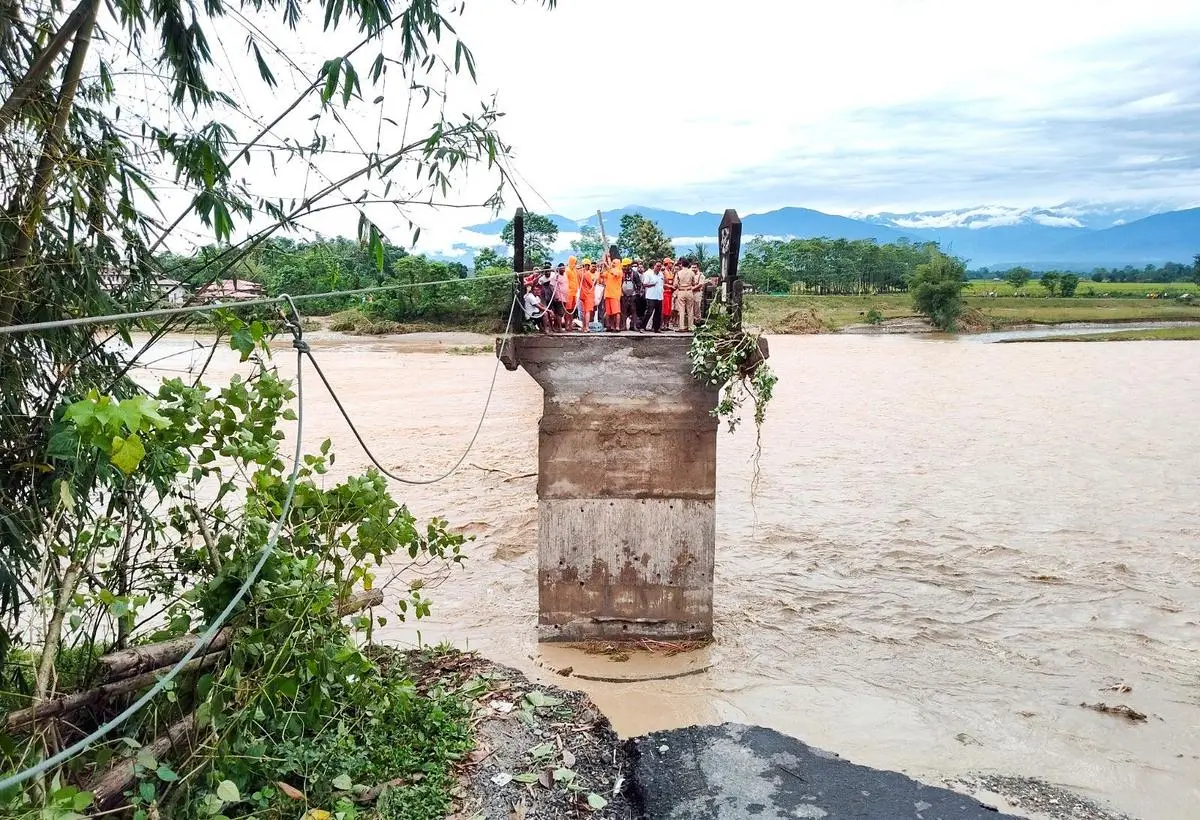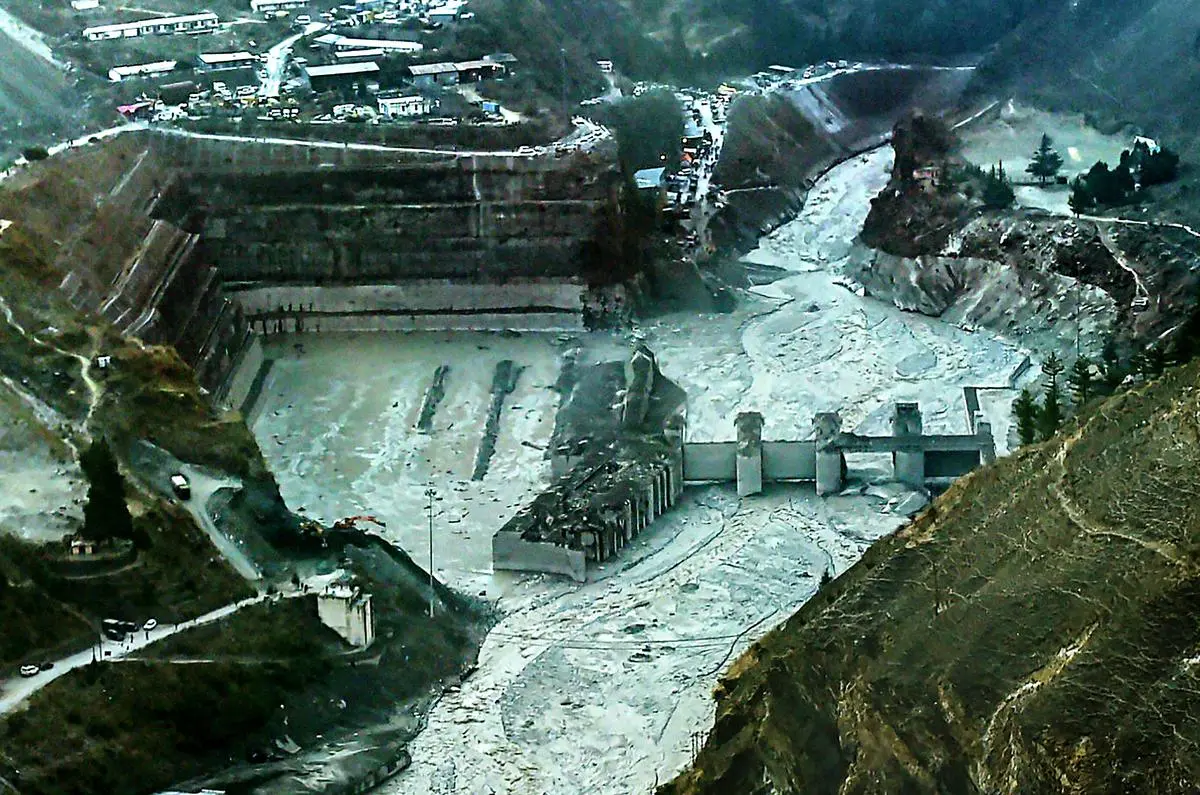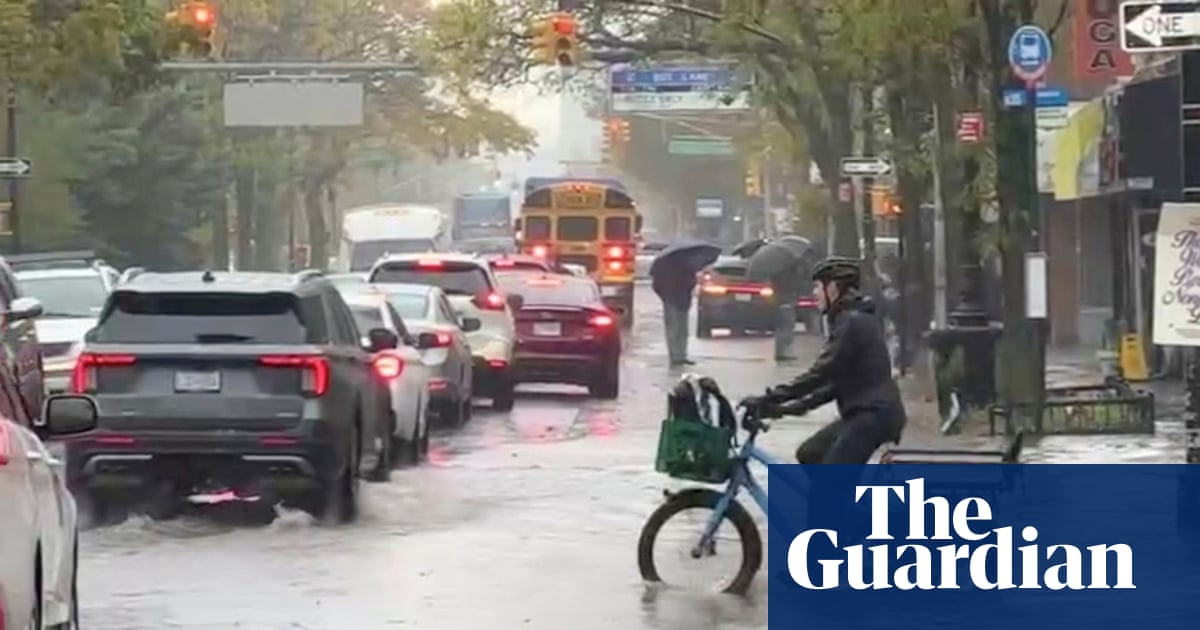West Bengal has been facing severe floods for decades—both in the southern deltaic regions and in the northern hills. Most recently, heavy rains over two days triggered floods and landslides across north Bengal, devastating parts of Jalpaiguri district and the Darjeeling hills. At the centre of the debate is the question of accountability: how much of the damage was caused by the alleged erroneous discharge of water by the Central government, as claimed by Chief Minister Mamata Banerjee, and how much stems from the state’s failure to prevent encroachment and illegal construction?

Ghosh said floods and droughts are integral components of the broader ecohydrological cycle.
| Photo Credit:
By special arrangement
Nilanjan Ghosh, an ecological economist and the head of Development Studies at the Observer Research Foundation, discusses these questions and examines the larger issues of flood management, governance, and ecological balance in West Bengal.
Mamata Banerjee has alleged that the floods were man-made, caused primarily by the erroneous discharge of water. Do you agree?
Let me address this point about calling a flood man-made. First, let us understand the science. Floods and droughts are integral components of the broader ecohydrological cycle—they are bound to occur. You cannot avoid them, nor can you deny or defy them. The issue today is not with floods themselves, but with flood damage. How are flood damages caused? They occur essentially because we come in the way of the river—it is not that the rivers come in our way.
Now, when we talk about flash floods or the sudden release of water from a dam, the absence of early warning systems can worsen flood damage, as people may not anticipate such a deluge. However, it is very unlikely that a sudden release of water happens without any kind of early warning, especially in the case of a system like the Damodar Valley Corporation (DVC), which was designed as a multipurpose project—one purpose being flood control, and the others hydropower and thermal power generation.
The concern today is whether such structures remain effective in the context of global warming, climate change, widespread encroachments, embankment construction, and unplanned urbanisation. These structures are no longer adequate to meet real-world challenges—that is the crux of the problem. It is a multiplicity of concerns and variables that have aggravated flood damage. Floods themselves, as I mentioned, are integral components of the ecohydrological cycle, and they have their own benefits—especially across the Ganga-Brahmaputra-Meghna (GBM) basin.
A key characteristic of floods in the GBM basin or the Himalayan river system is that they are not merely flows of water; they also carry sediment. In our research, Jayanta Bandyopadhyay at IIM often described the Himalayan river system as an equilibrium of waves, water, energy, biodiversity, and sediment.
When you construct large projects or engage in structural engineering to extract hydropower, you disrupt the natural flow regime. Sediments begin to settle further upstream. At the same time, under the assumption that such projects will control floods and prevent future releases, we continue unrestrained urbanisation and economic development downstream.
If the river changes course, or if a flash flood or cloudburst occurs, the entire system—already strained—becomes incapable of managing such a deluge. That is the real problem. So, it is not merely the question of an absent early warning system—I don’t believe that was the case here, given that a flood control mechanism existed. Rather, it is the interplay of multiple factors that has aggravated flood damage in north Bengal and further downstream along the Teesta [river].
Also Read | The hungry river in West Bengal eats up homes overnight
Talking about global warming and climate change, let us discuss what precipitated the floods in north Bengal. There were two days of very heavy, unprecedented rain. I recall an earlier conversation with you where you said it is not possible to determine rainfall patterns, particularly in the Himalayas. In that context, what should the government do, given that it cannot control or predict such catastrophes?
That’s a critical general concern you’ve raised. One key factor behind the flooding has been attributed, legitimately to some extent, to the release of water from the storage or hydropower system in Bhutan, which turned out to be defective. This caused excess water flow towards this side, resulting in the deluge in north Bengal.
We don’t have any agreement on data sharing for early warning systems for these river systems—and that is something we need. How can such a mechanism work? For example, we have an agreement on the Yarlung Tsangpo-Brahmaputra system with China. During the high-flux monsoon season, they share data twice a day from three measuring stations located on the Tibetan side of the Himalayas. Similarly, with Bhutan, we can identify measuring stations to forecast the amount of water likely to flow into India—whether in West Bengal, Sikkim, or elsewhere, depending on the river system.
We need a broader, integrated, basin-level approach; it cannot remain fragmented across stations or States. This approach is missing in South Asia. That’s why I ask: why do we look at floods as disasters? Floods shouldn’t be disasters—they are an integral part of the ecohydrological cycle.
Why do we call the floodplains of Bihar or the lower Ganges the “rice bowl”? Because traditional knowledge systems recognised floods as inevitable and made full use of them. When floodwaters receded, they left behind rich alluvium, which enhanced soil productivity over time. When we built large embankments and other structures—driven by our hangover from the British colonial engineering legacy—we impeded the natural ecosystem processes of the river basin. We converted floods into flood damage, and the ecosystem services of sediments into disservices.
We stopped sediments from reaching the delta with the construction of the Farakka Barrage, which traps sediment further upstream. Those sediments once built the Ganges Delta. Kolkata is part of that delta, though not the active one—the tidally active delta lies further downstream, in the Sundarbans.
The Sundarbans is shrinking. The Ganges Delta is shrinking due to two forces: sea-level rise from global warming and climate change, and the loss of sediment flow through creeks, canals, and distributaries, which once raised the land. The delta is thus shrinking because of both the global force of climate change and the local impact of the Farakka Barrage. This is the critical condition we face today. Multiple factors have turned floods into a negative phenomenon, and we need to correct course—but doing so will entail a huge cost.

NDRF evacuate people through a zip line during a Flood Water Rescue operation in flood-affected areas, in Jalpaiguri on October 5, 2025.
| Photo Credit:
ANI
You said something interesting about a colonial hangover in engineering. By that, did you mean the numerous hydropower projects in Sikkim and some in West Bengal? Are you saying these projects are outdated, or that they need to be modernised or replaced?
The problem with hydropower in the Himalayas is that we never consider the cost holistically. If you drive along the Teesta, from West Bengal to Sikkim, you might find around 29 or 30 hydropower projects—some functional, some not.
During the dry season, there isn’t adequate flow. Around 24 to 26 hydropower projects are planned in Sikkim and about four or five are functional in West Bengal. None of these are truly run-of-the-river projects, despite being claimed as such. Run-of-the-river projects simply use the natural flow to generate power without altering or impeding it. But most have a storage mechanism—some kind of pondage upstream—because in summer the river runs dry, and the flow alone isn’t enough to generate power. So they store water and release it later, sometimes after several hours, generating hydropower for only five to six hours a day. This is problematic because the river is getting fragmented. Geographers and hydrologists often stress that a river is an integral unit, and this fragmentation kills it. When water doesn’t flow downstream for six to 12 hours a day, it completely disrupts the basin’s ecosystem. What happens to fisheries and other species dependent on that flow?
At Gazoldoba on the Teesta, a certain amount of water has to be diverted for urban needs—especially for the growing centres of Jalpaiguri and Siliguri. The issue is not just urban water consumption. On both sides, large patches of dry-season paddy—major water guzzlers—are also cultivated. The same phenomenon prevails in Bangladesh. Hydropower itself is not the sole destroyer of the river system—any form of construction, storage mechanism, or multipurpose project has similar effects. But is hydropower sustainable in the Himalayas? That’s a big question. Many of these projects are located in extremely active, seismically prone regions.
Two critical knowledge gaps persist. One concerns the mechanism of cloudbursts—why they occur and how to predict them. This science is still not well understood in the Himalayan system. The other is seismicity—can we really forecast earthquakes? If an earthquake occurs, what will be the downstream impact on these barrages and dams? These remain unanswered questions.
Hydropower in the Himalayas may seem attractive given its huge potential, but what are the costs? These costs are never reflected in the cost-benefit analyses of such projects. That must change. Decision-making on hydropower cannot be guided by economics alone. It must include holistic ecological economics in the integrated cost-benefit analysis of these projects—something missing from the current discourse.
Hydropower projects can be beneficial if all precautions are taken, all costs are accounted for, and they are designed to mitigate risks. But a reductionist engineering approach—“I just want to build hydropower and generate electricity”—can be disastrous.
You mentioned 30 hydropower projects along the Teesta—a formidable number that seems disastrous in itself. Is it wise to have so many, and is there any alternative you can suggest?
Of course, it’s not wise to have so many. No doubt about that. Most of those operating in Sikkim are private hydropower projects. The question is: how do we maintain the integrity of the river and the flow regime?
We must not forget that the Himalayan system is highly dynamic—unlike the peninsular rivers. It’s a combination of glacier, snow, and precipitation, with a huge amount of sediment. These rivers also emerge from seismically active regions. The clear transboundary dimension makes the problem even more complex. If we talk about the Ganges-Brahmaputra-Meghna system and their tributaries together, they are shared by multiple nations—China, Bhutan, Nepal, and Bangladesh. If we consider the Indus as part of the Himalayan Hindu Kush system, Pakistan and Afghanistan are also involved. This makes the entire river system a complex challenge.
Always remember: if one part of an integrated ecosystem is disturbed, the impact might not appear locally but may be felt far downstream. Just as the construction of the Farakka Barrage altered the flow regime and affected the Sundarbans, similar consequences occur elsewhere when systems are interconnected. This understanding of integration has been missing so far in our reductionist approach to water engineering.
The entire brick-and-mortar system institutionalised through the Central Water Commission is dominated solely by engineers. They view water merely as a stock resource to be stored for human use. But water is not like that, nor is it meant for short-term human use. If civilisation is to survive, we must see water as an integral component of the natural ecohydrological cycle on which life and ecosystem structures depend. It functions organically and provides human society with vital ecosystem services. If we interfere, the ecosystem structure and function are disrupted, leading to the loss of long-term services like soil formation and declining fish catch in the delta.
This has happened elsewhere. Across the EU and the US, more than a thousand projects have been decommissioned since 2015. Between the 1920s and 1960s, those same countries were at the forefront of dam building—the so-called “dam-building decades”. Today, they are dismantling them.
The EU decommissioned dams through the 1980s and ’90s. In many cases, fish returned to the streams. They have been incentivising farmers to keep water in-stream through various mechanisms. One reason desert areas in the western US dried up was dam construction. Here too, we need to move beyond the mindset that dams equal development. We need better-informed structures that reflect integrated social and ecological thinking. We cannot keep building unsustainable structures that cause more harm than benefit—because humans will bear the cost.
Today, in the entire mechanics of global warming and climate change, we are both the perpetrators and the victims. Conservation is a selfish human need—for our own development and the progress of civilisation. That is precisely why we cannot think only of growth. We must also account for the costs of growth, and the biggest cost we face today is climate change.

An aerial view of the Tapovan hydropower project plant washed away by the flash floods in Chamoli, Uttarakhand, on February 12, 2021.
| Photo Credit:
PTI
Mamata Banerjee was not too far from the truth when she said there is no need for dams anymore—a statement that drew considerable criticism from her political opponents.
Well, do we need dams or don’t we? That’s the big question. Do we need the DVC? The concern was not with dams in general—it was with the Damodar Valley Corporation. DVC was a structure of the 1940s. Let’s not forget it’s a multipurpose project. Even today, a component of electricity in West Bengal and Jharkhand depends on the it, including hydel and thermal. Do we have an alternative? That’s the big question. We need to create alternatives and substitutes.
Second is flood control. DVC was also meant to help control floods. Does it serve that purpose? The dynamics and knowledge systems have changed over time. Can it control floods if there is very high precipitation downstream? It can’t. Can it control floods beyond its capacity? It can’t. The mechanism of flooding and monsoonal precipitation has changed, but the structure has not evolved. You cannot have a static solution for a dynamic problem. DVC is a static structure, while the problems have evolved. So, we need a different structure. But that doesn’t mean we don’t need dams at all—we possibly do, for other purposes.
Let’s face it—hasn’t China constructed dams? But China also has sediment separation technology and practices. The Yellow River is the most sediment-laden river in the world. Yet, they separate and flush sediment downstream so the rich alluvium can be used for organic agriculture. We have to combine traditional indigenous knowledge with modern systems. When the Roorkee Engineering College was created, the same engineering paradigm prevailed—but that cannot govern today’s river systems. There has to be a paradigm shift.
Civil engineering structures must evolve to include ecosystemic and societal concerns. Economic ambitions must align with them. Earlier, development meant only economic growth. Now, we talk about the Sustainable Development Goals—poverty alleviation, environmental sustainability, human wellbeing, innovation, industries, and combating climate change. Today’s development paradigm seeks to reconcile what I call an irreconcilable trinity: economy, ecology, and society—that is, equity, efficiency, and sustainability. We must promote equity through poverty reduction and health, enhance efficiency through better practices, and build sustainability into development.
So, can dams help reconcile this trinity? If well-designed, they can. Can we have better agricultural practices that enhance productivity without compromising soil health? Regenerative agriculture does that—improving productivity, ensuring soil health, and providing better nutrition. It addresses human capital, productivity, and sustainability. These are the kinds of solutions we need to think of.
Also Read | Sundarbans residents bear the brunt of climate-induced displacement
You have pointed out that it is very difficult to predict cloudbursts and rainfall, particularly in the Himalayan region. You also mentioned the existence of dams and the lack of coordination between the Centre and the State, between States, and between the state and the government of Bhutan. In this situation, what needs to be done immediately? We may not be able to prevent floods, but at least we can minimise their impact on the region.
Globally, people have been talking about integrated river basin governance, and several transboundary river organisations have evolved as effective institutions for managing such projects across river basins. The problems, however, are much more complex for the Himalayan river systems. Most of these institutions have evolved in the EU, though the Mekong basin offers one effective example in the Himalayan context.
The challenge with the Ganges and Brahmaputra systems—the Himalayan rivers passing through India—is that you also need a congenial geopolitical scenario to develop an integrated approach. Given the geopolitical suspicion in South Asia, it will be difficult to create a transboundary river basin organisation. But that would have been an ideal platform had there been cooperation or some agreement among India, Bangladesh, China, Bhutan, and Nepal—any form of transboundary river basin organisation for the Ganges-Brahmaputra-Meghna system. Even if that is not possible, memoranda of understanding can still be worked out between nations across risk-prone regions affected by flash floods or cloudbursts, enabling data sharing. This can help develop early warning systems through better modeling.
Between India-Bhutan, India-Nepal, and India-Bangladesh, such mechanisms already exist in the context of the Ganges, where we share flow data during the monsoon. But a more holistic agreement can be developed among these nations for broader transboundary data sharing. We also have such an agreement with China, but I have criticised it because the choice of measuring stations is unhelpful in providing any advance warning. There must be a proper scientific basis for selecting those stations from which upstream nations can share data with downstream nations.
With proper early warning systems, we can manage flood damage more effectively and gain better knowledge of river behaviour. This is a long-term goal, though interim agreements can be made within a year or so. In the long term, we must understand the river’s course. Every Himalayan river changes its course because of sedimentation. Earlier, we created flood zones to predict flood-prone areas, but those models are failing.
We should also draw on traditional knowledge. Communities once understood how rivers changed course—knowing floods might hit the east bank one year and the west the next. We must create space for the river and stop encroaching on it due to unbridled urbanisation and growth. That is why properties are being damaged today. If we develop knowledge systems that prevent encroachment into the river’s space, we’ll be in a better position to manage floods.
Third, avoid man-made measures like embankments. In most cases, local-level embankments have been poorly designed and often breached, worsening floods. It’s crucial to understand the river’s course and the extent of its expansion. We must not come in the river’s way and must consider that entire path as the river’s right of way. An integrated approach is possible only through a better social, ecosystemic, and economic understanding of the river system.


